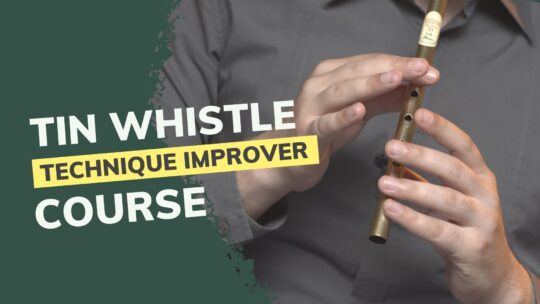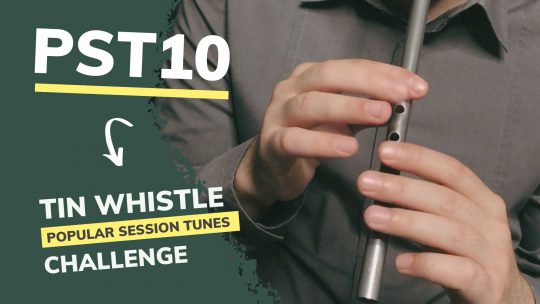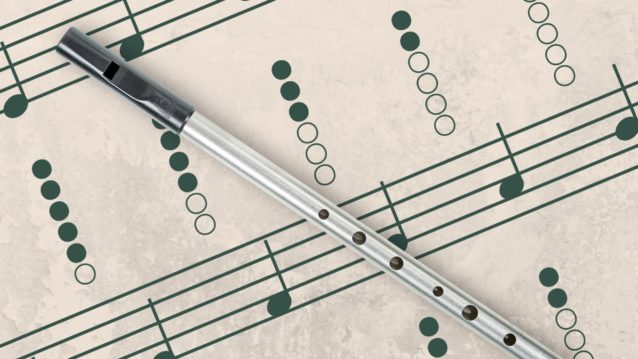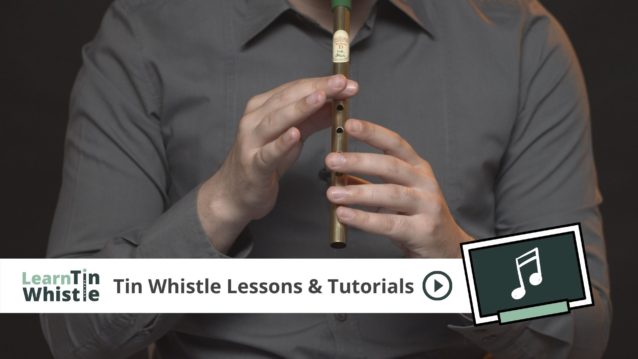In this lesson, we are going to talk about how to properly blow into a tin whistle and create your first sound. Learning to blow the whistle correctly is one of those things that are easy to overlook, even though it’s the foundation. When it comes to woodwinds, consider the airflow as a crucial part of the instrument. It’s like fuel to an engine. So, grab the whistle, and let’s start making it sound good!
Avoid touching your teeth
As we mentioned in the previous lesson which explains how to correctly hold the whistle, put the mouthpiece between your lips while making sure you are not touching your teeth with it.
Make a correct posture
We need to allow unobstructed airflow from your lungs and mouth all the way to the whistle. Be relaxed, but make sure to sit upright. Or stand, if you prefer.
How to blow into a tin whistle?
One of the most common beginner mistakes is to start blowing too hard. Do not overblow, as it is very easy to do it, especially at a lower octave. Try to breathe rather than blow into it. A good beginner exercise is that you put the whistle aside, then start blowing with the mouth closed, holding your breath. You should feel the air pressure. Try to manipulate it. Now, try this with the whistle inside your mouth. Start with very low pressure and raise it until you have just enough air to hear the consistent, rich sound of the whistle. This one is challenging to explain, but you will feel it when it sounds just right. There you go!
Every single whistle requires a slightly different mouthpiece position and a certain amount of air on certain notes. Keep that in mind as even if you are not a complete beginner, once you switch to another whistle type (brand), it will take some time to get used to it.
Why does a whistle squeak?
If you ask yourself why the whistle sounds squeaky (not clear-sounding), do not worry. It might be tricky at the beginning. First, regardless of the blowing pressure that is required, a whistle needs a continuous, steady flow for stable notes. Also, keep in mind that a tin whistle’s lower octave notes need less air than the upper octave ones, even though the fingering is the same. That’s how you actually jump through the octaves. But, generally speaking, some whistles require more air than others, while some are very easy to overblow. Not to mention different mouthpiece types. So, we suggest you start with the lowest note, usually D (all holes covered), as this note is the air pressure threshold.
Also, it’s sometimes better not to blow directly into the whistle. Try to slightly move the mouthpiece up and down between your lips until you find the perfect angle for the airflow. You will hear the point where the whistle starts to sound more clear.
Do not pause blowing when changing notes
Another common thing that many beginners neglect is that you shouldn’t pause the blowing between the notes. Once you get familiar with the right amount of air you need and start playing your first simple melodies, make sure you are changing the notes on a continuous airflow.
How to play high notes on a tin whistle?
Fingering for the upper octave is the same as the lower octave, and you reach the higher octave notes by blowing harder. However, most beginners find it especially tricky to control the airflow on higher notes. First of all, you should keep in mind that mastering the higher octave takes more time and practice, so don’t get disappointed if you don’t sound great after your first whistling day. A higher octave needs more direct air and a bit more pressure (speed). For example, imagine you are blowing through a drinking straw. A good tip is to blow in shorter bursts (not longer than a second). Once you get the correct sound, try to lengthen the duration of the notes.
Also, when a tune or a musical part starts with a higher note, it’s very common to use tonguing (next lesson) instead of just blowing. Tonguing is what gives more accent and an initial “punch” to the note, which usually helps to reach the required amount of air pressure.
Every single whistle requires certain amount of air on certain notes. It takes time to figure it out.
LearnTinWhistle.com
Keep practicing to get used to the right amount of air pressure
Start with the lowest D note (all holes covered), and then play a full scale on the lower octave (D, E, F#, G, A, B, C#, D), and then go backwards. Once you think the lower octave sounds good, move to the upper octave and play the scale too. Another useful exercise is to do octave jumps on the same note. So, play lower D, then upper D, repeat a couple of times, and move on to the next note. When it starts to feel boring (as playing scales always does), play and jump through some notes freely, creating a random melody. Or, try to replicate an easy and slow song you are familiar with.
Remember, the goal at this point is to learn how to control your breath and the airflow. Don’t bother with unnecessary “rings and bells”. We’ll come to that later.





I am unable to get more than half of the second octave without getting nothing but squeaks. I used to play the pipes so have worked hard to reduce pressure, can now manage the lower notes. Any suggestions?
Hi Bruce,
Since you’re coming from the pipes, it might actually help to try a whistle that can handle a bit more air pressure — some models are more forgiving in that way.
Aside from that, it really comes down to practice and giving yourself a bit of time to adjust. I’d suggest focusing just on those higher notes for a while. As a simple exercise, try playing through the high range and holding each note for at least 2-3 seconds and really pay attention to how much pressure it takes to keep them stable without squeaking.
My blowing is warbly on the whistle. I play the recorder and I do not have this problem. What to do?
The warbly sound you’re getting on the whistle usually means the air stream just needs a little adjusting. It could be related to the specific whistle model, but compared to the recorder in general, the whistle often needs a gentler, steadier breath. Try easing up a bit on the pressure and aiming for a smooth, even flow of air. Think of it more like a soft, steady breeze rather than a strong puff.
I’ve heard that when playing the tin whistle, you should breathe from your diaphragm and not just from your lungs. It’s also called belly breathing? What does that mean, and how do you do it?
Belly breathing involves expanding the diaphragm to allow deeper breaths. Basically, you are filling the lungs fully without raising the shoulders. This technique helps maintain a steady airflow, which improves tone and control.
However, it is not crucial for playing a whistle since the whistle doesn’t require much air to be played. It’s typically used by classically trained musicians for other wind instruments.
Here’s a nice video explaining it: https://www.youtube.com/watch?v=4dfkM5AubCU